Selection of Traverse Unit
When selecting a Traverse unit model, it's crucial to account for the various forces and factors that influence its performance. This selection process takes into consideration the cumulative effects of the weight of the Traverse unit, associated assemblies being traversed, frictional load, linear speed, and other parameters. For spooling applications, the tension in the material being traversed also needs to be factored in, as well as the distance between the final capstan/support point and the traverse unit. The equation for calculating the side thrust (F) exerted on the traverse unit is as follows:
Side thrust F (Kg) = 0.25 (M × V / T) + Fr + Fz + 0.12 (M × G) + Fw
Where
- M is the total weight to be traversed.
- V is the maximum linear speed in meters per second.
- Fr represents the friction load in kilograms.
- G is the gravitational force, approximately 9.8 m/s².
Fw is the Force related to winding tension calculated as follows


Refer to Figure 15 for visual representation and further details. Where:
- C is the traverse length in millimetres.
- T is the winding tension in kilograms (usually around 5 to 10% of the maximum tensile strength of the material being wound).
- B is the distance between the traverse and the let-off point in millimetres.

For ease of selection, you can pre-select a model by roughly estimating the required force using the above calculations. This preliminary estimation can guide you in choosing a suitable Traverse unit model that can handle the expected forces and perform optimally for your specific application.
Download Catalogue